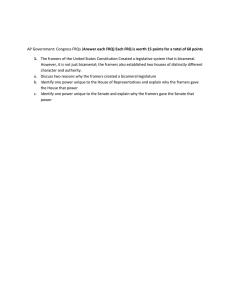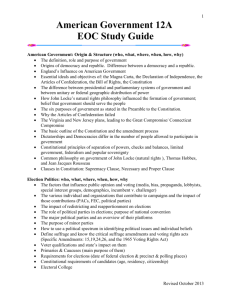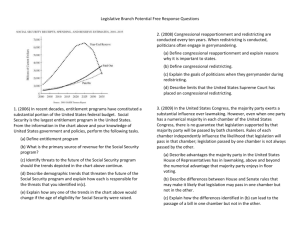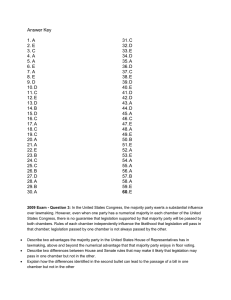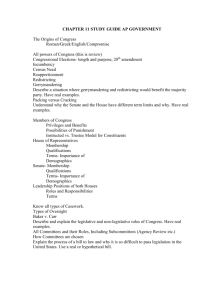Legislative Branch Potential Essay Questions (One of these will
advertisement
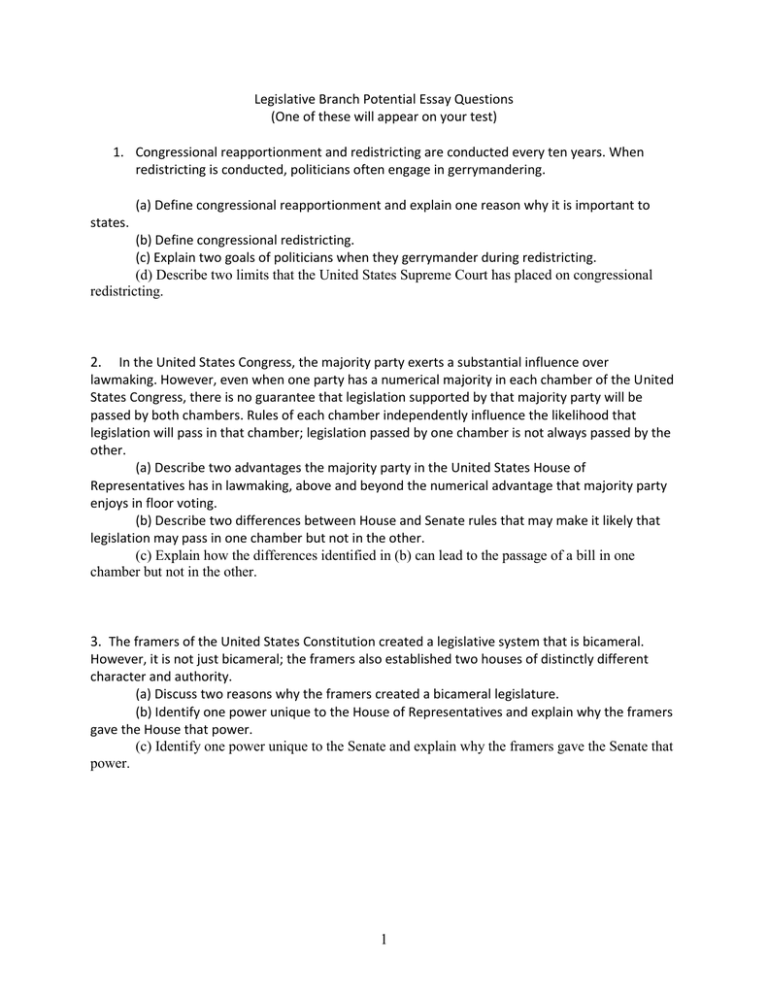
Legislative Branch Potential Essay Questions (One of these will appear on your test) 1. Congressional reapportionment and redistricting are conducted every ten years. When redistricting is conducted, politicians often engage in gerrymandering. (a) Define congressional reapportionment and explain one reason why it is important to states. (b) Define congressional redistricting. (c) Explain two goals of politicians when they gerrymander during redistricting. (d) Describe two limits that the United States Supreme Court has placed on congressional redistricting. 2. In the United States Congress, the majority party exerts a substantial influence over lawmaking. However, even when one party has a numerical majority in each chamber of the United States Congress, there is no guarantee that legislation supported by that majority party will be passed by both chambers. Rules of each chamber independently influence the likelihood that legislation will pass in that chamber; legislation passed by one chamber is not always passed by the other. (a) Describe two advantages the majority party in the United States House of Representatives has in lawmaking, above and beyond the numerical advantage that majority party enjoys in floor voting. (b) Describe two differences between House and Senate rules that may make it likely that legislation may pass in one chamber but not in the other. (c) Explain how the differences identified in (b) can lead to the passage of a bill in one chamber but not in the other. 3. The framers of the United States Constitution created a legislative system that is bicameral. However, it is not just bicameral; the framers also established two houses of distinctly different character and authority. (a) Discuss two reasons why the framers created a bicameral legislature. (b) Identify one power unique to the House of Representatives and explain why the framers gave the House that power. (c) Identify one power unique to the Senate and explain why the framers gave the Senate that power. 1 Other Things To Know! Congress I. (435 representatives and 100 senators)….House v. Senate – Requirements for each A) Party Leadership. Know: Speaker of House, President Pro Tempore, Majority and Minority Leaders, Whips, caucus B) Powers Unique to the Senate 1) Treaty ratification 2) Confirmation of judicial and executive appointments. 3) Try impeachment/conviction/removal from office These powers are unique because: 4) More mature body 5) More insulated from public opinion/ indirectly elected (originally) 6) Longer and/or staggered terms. 7) Reflects state interests C) Powers Unique to the House 1) Initiate revenue bills. 2) Choose the President when the Electoral College is deadlocked. 3) Impeachment. These powers of unique because: 4) Closer to the people. 5) More representative of and responsive to the public/direct election to two-year terms. D) Additional Powers 1) Congress is empowered to create new federal courts and specify the number of judges who will sit on them. 2) One of the formal tools used by Congress for oversight of the bureaucracy is authorization of spending. 3) The congressional power that has been contested most frequently in the federal courts is the power to regulate interstate commerce (think: Gibbons vs. Ogden) Incumbency is the most important factor that determines which candidate will win an election. (win more than 90% of time). This provides expertise and stability to Congress but also insulates it from change. 1) Incumbents in the House are more likely to be reelected, however, because Senators are more high profile and are more likely to be held accountable for public policy. 2) Advantages of incumbents: (a) Advertising/name recognition (b) Credit claiming: can work for constituents pork barrel or casework. (c) Position Taking: public image strengthened because already taken a stand on issues relevant to their constituents. (d) Party Identification: voters vote on party lines, thus how a district tends to lean will affect whether or not an incumbent wins. (e) Campaign spending: often due to contributions from interest groups and PAC’s E) Franking privilege is extended to all members of Congress. It means members of Congress can send mail to their constituents at the government’s expense. II) Congressional boundaries are drawn by state legislatures (know: gerrymandering, malapportionment, reapportionment, redistricting) A) “critical elections” are most likely associated with party realignment. III) Committees A) House Rules Committee sets conditions for debate and amendment of most legislation. Also puts bills on calendar for debate. 2 B) Appropriations Committees (both houses)- decides how government money will be apportioned to federal agencies. C) House Ways and Means Committee- writes bills concerning tax and other public revenue. D) Senate Finance Committee-works with House Ways and Means Committee to write tax revenue bills. E) Types: 1) Standing: handles specific policy area. Both House and Senate have them. Often divided into subcommittees. 2) Joint Committees: oversee areas where policy overlaps. Made up of representatives and Senators. 3) Select Committee: handles specific issues, like an investigation or impeachment trial. 4) Conference Committee: iron out differences between the House and Senate version of a bill. Have members of both Houses. F) Committee chairs influence agenda of most committees. Chair is a member of majority party and is the most senior member of majority party of committee. Minority party member with longest tenure called ranking member. The Seniority system was a formal rule used to select chairs, but is no longer a requirement. 3
